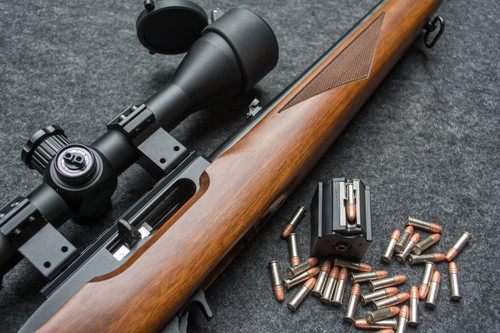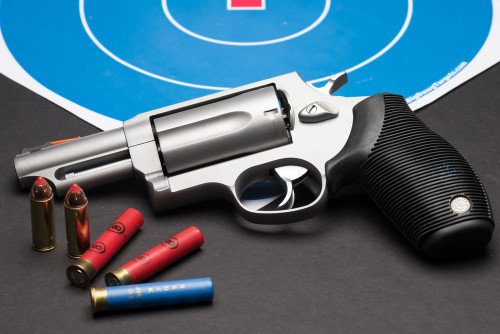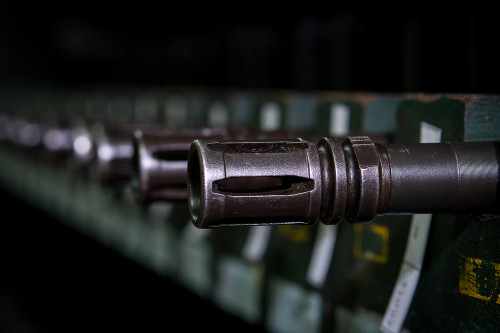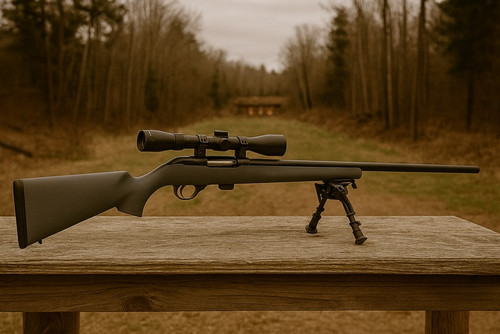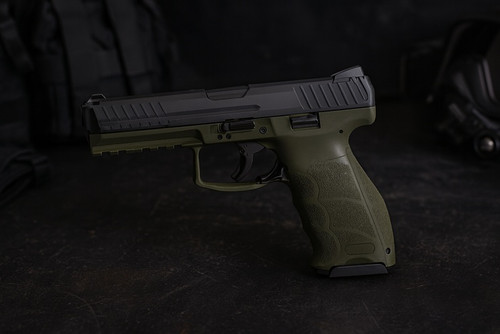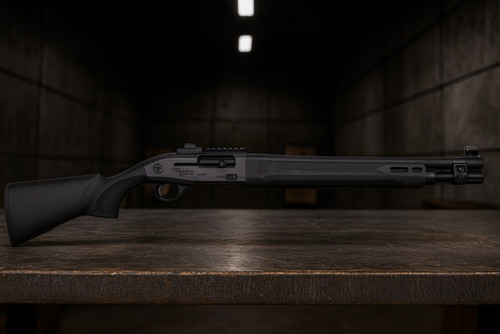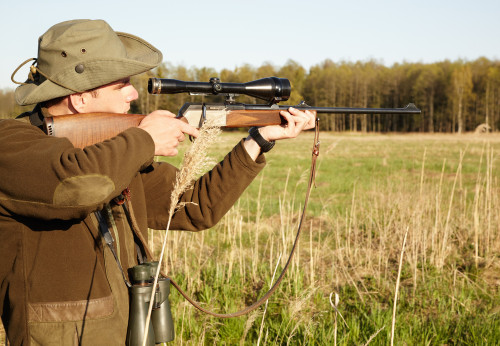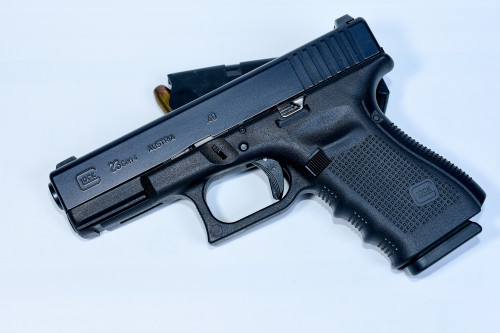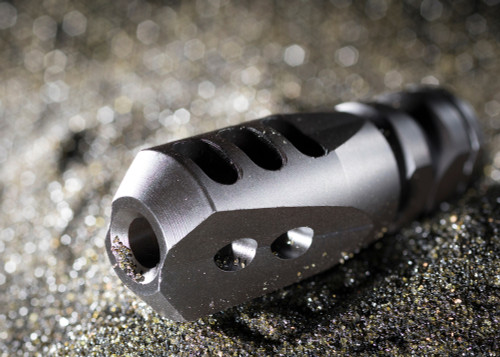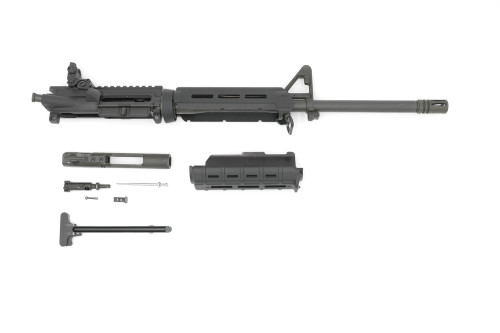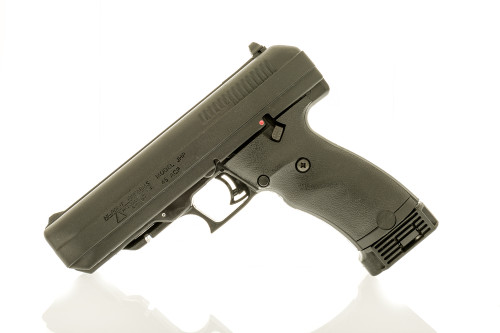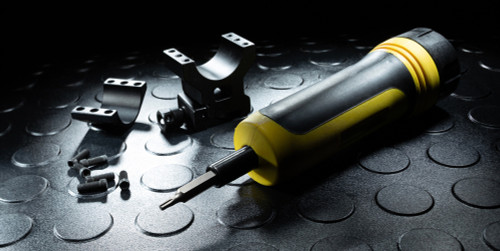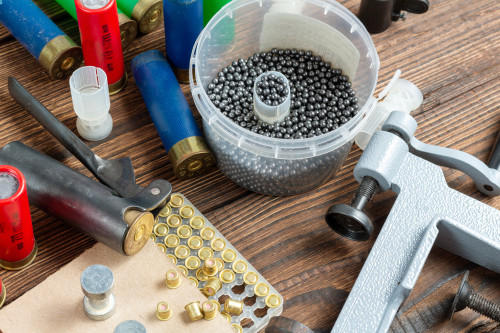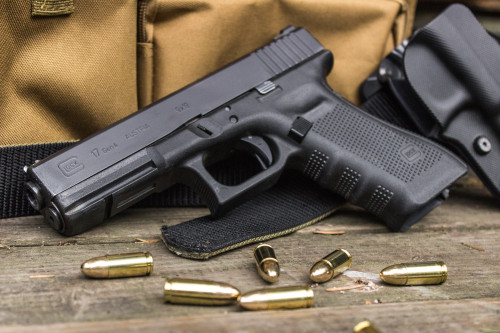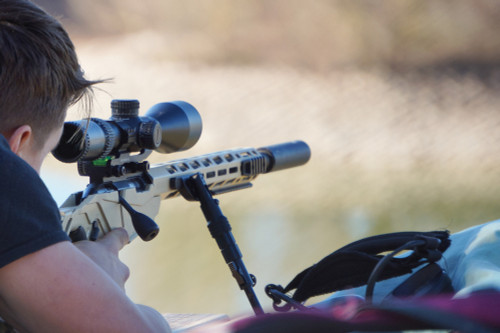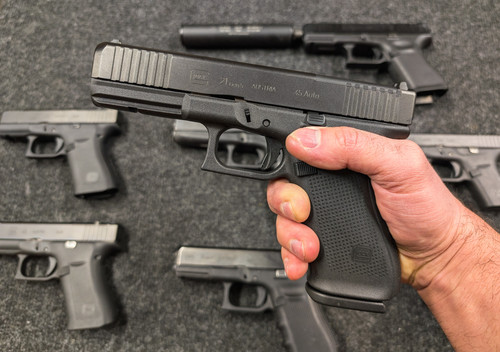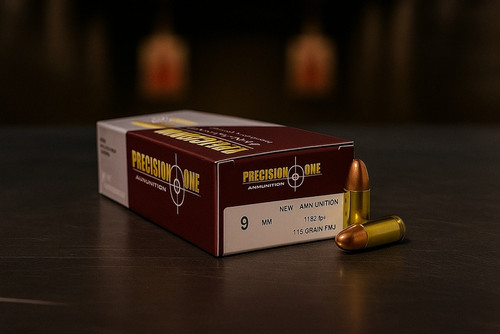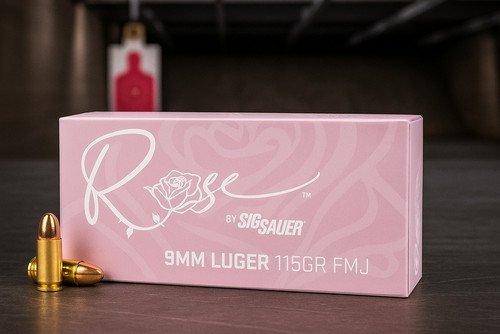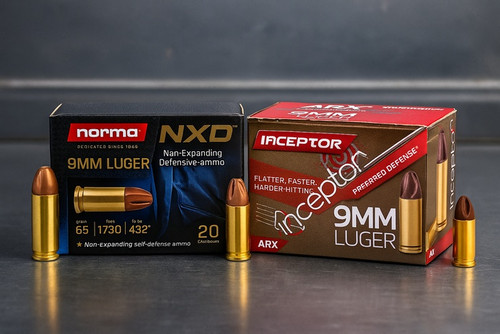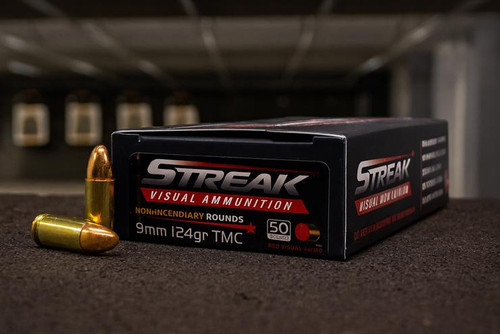Quick Answer
Top performers include the VG6 Gamma 7.62 (best all-rounder), Precision Armament M4-72 (maximum recoil cut), and SureFire ProComp 7.62 (great value). Budget options like DPMS Miculek deliver strong performance for less cash, and specialized units like the Lancer Viper provide exceptional reticle control for quick follow-up shots.
Key Takeaways
- Pick 5/8×24 thread pattern devices specifically rated for .30-cal.
- Balance recoil reduction against side-blast to neighboring shooters.
- Top ports and tunable jets help minimize muzzle rise.
- Some brakes offer pin-and-weld options to meet barrel length rules.
- Always double up on ear protection with braked .308 rifles. Peak impulse from .308 rifles is typically well above 160 dB at the ear; many brakes add several dB compared to flash hiders. Double up on hearing protection.
- Timing is crucial—position ports for your shooting style.
Data from controlled runs tells a clear story. Using identical .308 AR-10 platforms, a quality muzzle brake cut split times by up to 30% compared to standard flash hiders. Reticle tracking stays steadier, the sight picture snaps back faster, and follow-up accuracy climbs. For competition, hunting, or tactical applications, that add-up delivers real, measurable gains that are strong enough to justify investing in proper muzzle control.
.308 Muzzle Devices—Fast Primer
Let's get everyone on the same page about what these devices do. The three main types serve different purposes:
Flash hiders reduce the visible signature when you shoot. They typically use a larger exit aperture and prongs or a birdcage design.. They do little for recoil control.
Muzzle brakes focus on cutting recoil by directing gas sideways through ports or baffles. This counteracts the rearward push when you fire.
Compensators use top-facing holes to push the muzzle down. It fights the natural rise that happens after a shot.
Many modern devices blend these functions, but pure brakes remain popular for .308 rifles due to the cartridge's stronger recoil impulse. The goal is simple: less push back, less muzzle rise, and faster follow-up shots.
Threading matters too. Most .308/7.62 barrels use 5/8×24 threads, so all devices in our list use this standard pattern. Always verify your barrel's thread pitch before ordering.
The muzzle brake concept has evolved over decades of military and civilian use, with roots dating back to the 1800s. Early experiments showed promise, but effective implementation only became widespread in the 1930s with designs from companies like Bofors featuring the innovative "pepper-pot" style brakes.
How We Test (So You Can Compare Apples to Apples)
This comparison compiles manufacturer specs, lab/independent test reports, and aggregated user observations on consistent AR-10/.308 setups. Figures vary by test; where spreads were wide, we present ranges or “about” values rather than a single number.. Our approach leans on Pro-Armory’s team experience from military service, competitive shooting, and work in gun shops. We pair that with manufacturer specifications, third-party lab measurements, trusted published reviews, and aggregated user reports.
Platforms & ammo: For consistency, we compared figures for AR-10 style rifles in .308 Winchester with 16–18" barrels and common 150–168-gr loads. This platform shows up often in the sources we reviewed. Using one setup helps keep device-to-device comparisons meaningful.
Measurements considered:
- Recoil reduction (from manufacturer figures, independent lab data, and measured reviewer reports)
- Side-blast effect (based on wind-indicator data and range reports shared by testers)
- Sound levels at the firing position (using reported decibel measurements)
- Reticle movement / return-to-target observations (from high-speed video analysis posted by independent reviewers)
Range etiquette: We also factor how each muzzle device affects people on the line—an important point at busy public ranges—using reported observations and community feedback.
Data handling: We combined multiple independent data points and averaged reported values. This helps reduce the impact of any one outlier. When numbers varied a lot, we flagged that spread and used clear, plain summaries instead of one hard figure.
Scientific research confirms the complex thermo-mechanical conditions muzzle brakes face. Numerical simulations and experimental data show that projectile movement changes temperature patterns and peak forces. These factors tie directly to a brake’s efficiency and its service life.
The 10 Best .308 Brakes & Comps (Budget → Pro)
1. VG6 Gamma 7.62 (5/8×24)

The VG6 Gamma earns its place as an all-around workhorse for .308 platforms. It strikes an excellent balance between recoil reduction and muzzle control without excessive weight or length.
This brake uses a hybrid design with side ports for recoil control plus top slots that act as a compensator. The combination delivers a more complete recoil management package than pure brakes. It keeps your sight picture more stable.
Where the VG6 truly stands out is in practical application. It tames enough recoil to make quick follow-ups possible without being so aggressive that it ruins the shooting experience for everyone around you. It also includes a blind pin hole for permanent attachment if needed for barrel length compliance.
Price: $99
Features
- Hybrid side ports plus top compensation slots
- 5/8×24 threading for .30 caliber barrels
- Includes crush washer for timing
- Pin hole for permanent attachment option
- Nitride finish for corrosion resistance
Pros
- Strong recoil control for its size
- Consistent and predictable sight picture return
- Easy to time and install
- Available through many retailers
- Moderate price point
Cons
- Significant concussion for neighboring shooters
- Louder than flash hiders; at-ear peaks for .308 are typically 160 dB+ and brakes add several dB. Double up on hearing protection.
- Creates noticeable side blast
- Less tunable than jet-based designs
2. Dead Air KeyMount (KeyMo) Brake 7.62
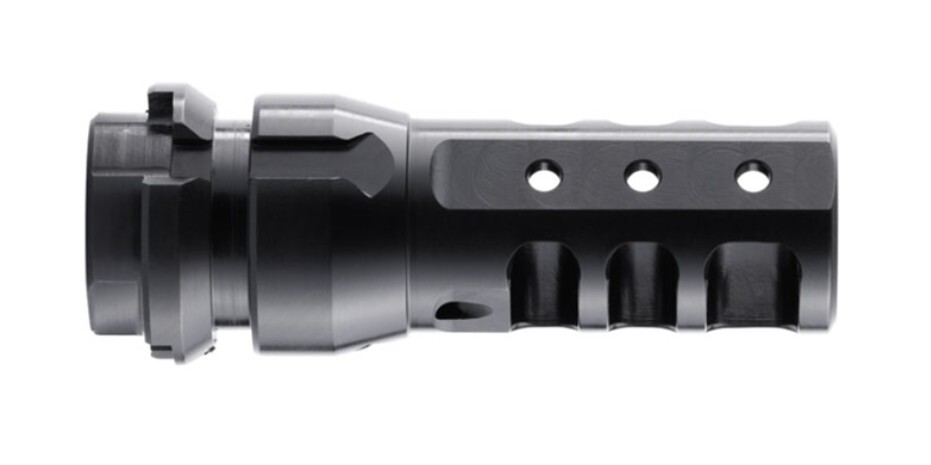
The Dead Air KeyMount stands out as a dual-purpose performer. It functions as an effective muzzle brake on its own but also serves as a quick-attach mount for Dead Air suppressors and other KeyMo-compatible silencers.
Testing shows this brake directs minimal concussion toward the shooter compared to other designs. This matters because many brakes reflect pressure back at you. It creates an uncomfortable shooting experience—the Dead Air avoids this common pitfall.
For those building a multi-purpose .308, this device offers a future-proof path. Start with effective recoil control today, then add a suppressor down the road without changing your muzzle device. The included shim kit allows precise timing without crush washers.
Price: $89
Features
- Built-in KeyMo suppressor mounting system
- 5/8×24 thread pattern for .308/7.62 barrels
- Includes timing shim kit for precise installation
- CNC machined from heat-treated stainless steel
- Durable black finish
Pros
- Excellent suppressor integration path
- Good balance of recoil control vs. concussion
- Minimal blast directed at shooter
- High-quality machining and finish
- Clear installation instructions with shim kit
Cons
- Heavier than minimalist brake designs
- Higher price point than basic brakes
- Commits you to KeyMo suppressor system
- Requires specific wrench for installation
3. Precision Armament M4-72 Severe-Duty (.308/7.62)
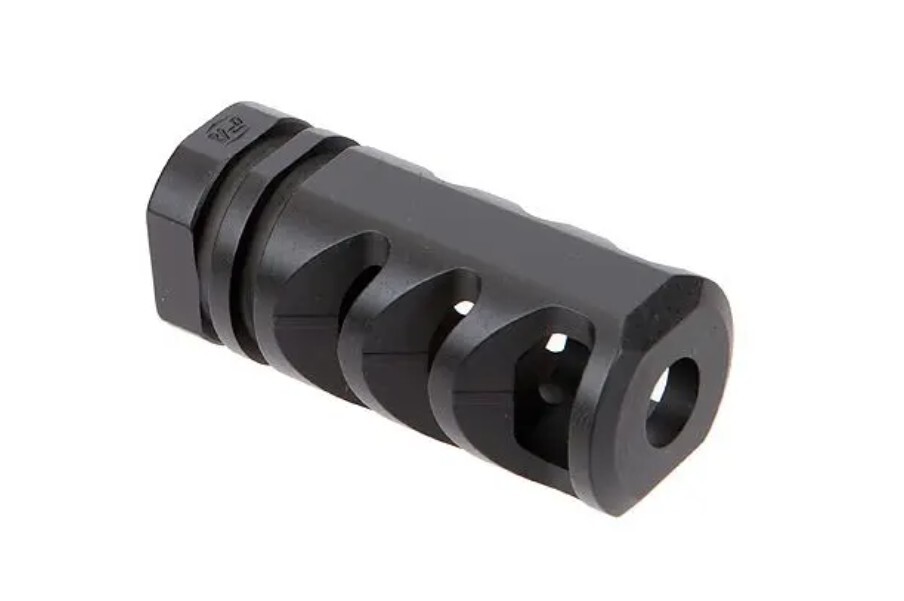
The M4-72 consistently tops objective testing for raw recoil reduction. Independent measurements show it cuts .308 recoil by a massive 64.4%. And so this places it at the very top of the performance chart.
This brake achieves its impressive numbers through a series of angled baffles that redirect gas in specific vectors. The design creates opposing force vectors that cancel out much of the rearward push and muzzle rise simultaneously.
Despite its aggressive performance, the M4-72 maintains a relatively compact form factor. It doesn't add excessive weight or length to your barrel. It makes it suitable for practical field use rather than just bench shooting.
Price: $89.99 - $99.99
Features
- Triple-baffle design with angled ports
- 5/8×24 thread pattern
- Closed bottom to prevent dust signature
- Heat-treated stainless steel construction
- Requires Accu-Washer system (not standard crush washers)
Pros
- Class-leading recoil reduction (64.4%)
- Compact and relatively lightweight
- Durable materials and construction
- Proven long-term performance
- Less concussion than expected for performance level
Cons
- Still creates noticeable side blast
- Requires specific installation method
- Utilitarian appearance
- Premium pricing
- Very loud to the shooter and adjacent lanes; expect 160 dB+ peaks at the ear and several additional dB versus a flash hider.
4. Fortis RED 7.62
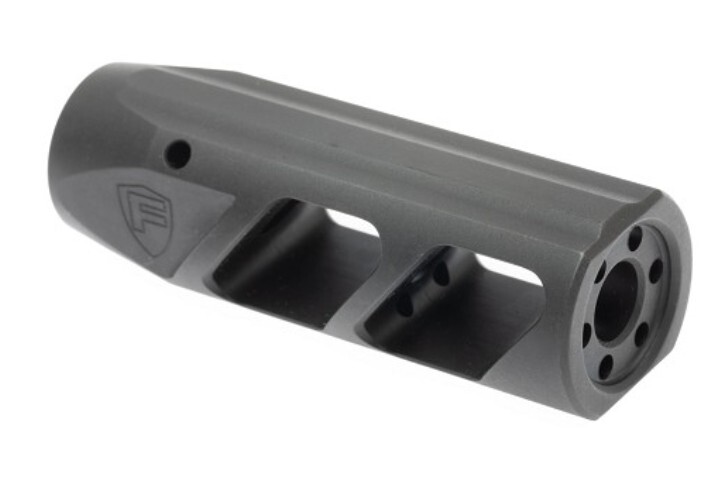
The Fortis RED (Recoil Eliminating Device) takes a different approach than most .308 brakes. Instead of maximizing raw recoil reduction at any cost, it prioritizes a balanced shooting experience with minimal concussion impact on the shooter and bystanders.
The design features a combination of carefully sized and angled ports that manage gas flow without the brutal side blast common to many aggressive brakes. This makes it more range-friendly and comfortable for extended shooting sessions.
For hunters and field shooters, the RED's compact size and lighter weight add minimal bulk to a rifle. The cleaner shooting experience makes it ideal for situations where you might not have advanced hearing protection for every shot.
Price: $64.95
Features
- 4140 steel construction
- Available in nitride or stainless steel finishes
- 5/8×24 thread pattern for .308 barrels
- Approximately 2.75" length and 3.8 oz weight
- Includes crush washer for timing
Pros
- Significantly reduced concussion profile
- Clean, attractive design
- Available in multiple finish options
- Lighter weight than many competitors
- Simple installation with standard tools
Cons
- Less total recoil reduction than top performers
- Limited tuning capabilities
- Finish options sometimes affect availability
- Not optimized for competitive shooting
- Mid-tier price point
5. Lancer Viper .308 (Adjustable Jets)

The Lancer Viper stands as perhaps the most user-tunable muzzle brake available for .308 rifles. Its defining feature is the four adjustable top jets that allow shooters to precisely control vertical movement based on their specific grip, stance, and shooting style.
Each jet can be individually adjusted or removed. It creates a custom gas flow pattern that counteracts your particular rifle's movement tendencies. This level of personalization delivers exceptional reticle stability—critical for rapid-fire accuracy.
The downside to this performance is size and weight. Roughly 3–3.5 inches long and about 4–5 ounces (model-dependent); substantially heavier than minimalist brakes but nowhere near 12 ounces., the Viper adds significant mass to your barrel. Its mass and multi-baffle design contribute to low-60% recoil reduction in some tests and excellent reticle control; actual results vary by rifle, ammo, and tuning.
Price: $252.39
Features
- Four independently adjustable top jets
- Large multi-baffle side port design
- 5/8×24 thread pattern for .308/7.62 barrels
- Includes jam nut and adjustment tools
- Steel construction (vital for heat and erosion resistance on .308 brakes).
Pros
- Superior reticle stability and return to target
- User-customizable for personal shooting style
- Exceptional recoil reduction (63.7%)
- High-quality construction and finish
- Complete tuning kit included
Cons
- Very large and heavy (nearly 12 oz)
- Premium price point
- May exceed competition rules in some divisions
- Overkill for casual shooting
- More complex installation and setup
6. SureFire ProComp 7.62 (5/8×24)
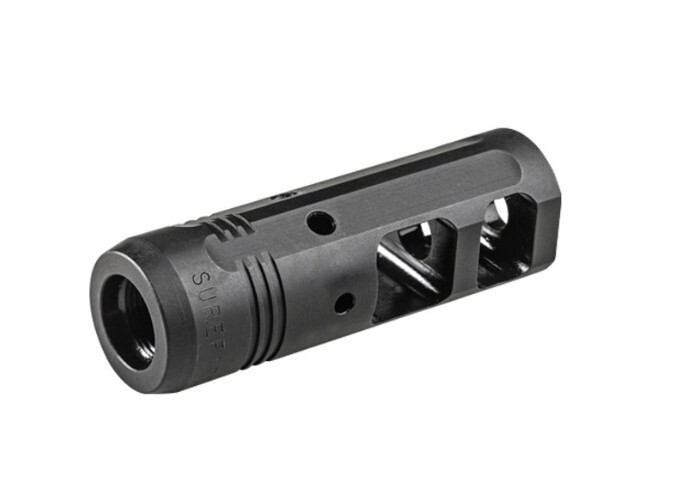
The SureFire ProComp delivers impressive performance at a mid-tier price point. Test data shows it reduces .308 recoil by approximately 53%—excellent efficiency for its compact size and weight.
This hybrid design features two major side ports for recoil reduction plus two smaller holes on top that act as compensator ports. SureFire also added a thoughtful touch: pre-drilled pilot holes at 3 and 9 o'clock that can be opened up for customized lateral control.
For those looking to permanently attach a muzzle device to meet minimum barrel length requirements, the ProComp includes a pre-drilled blind pin hole at the 6 o'clock position. This feature, combined with its balanced performance, makes it one of the most versatile options available.
Price: $99
Features
- Hybrid design with side ports and top compensation holes
- Pilot holes at 3 and 9 o'clock for optional lateral tuning
- Blind pin hole for permanent attachment
- 5/8×24 thread pattern for .308 barrels
- Precision machined from high-grade steel
Pros
- Excellent value-to-performance ratio
- Moderate concussion levels
- Tunable with simple drilling of pilot holes
- Pin-and-weld option built in
- Balanced recoil and rise control
Cons
- Some right-biased reticle movement
- Requires drilling for full customization
- Generates typical brake-level blast; at-ear peaks for .308 are 160 dB+ (brakes add several dB over flash hiders).
- Not specifically optimized for competition
- Less aggressive recoil control than top-tier options
7. Ultradyne Apollo Max (7.62)
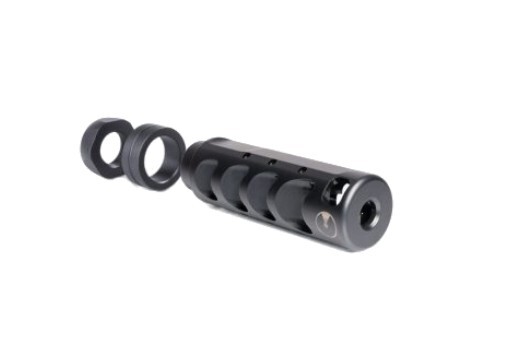
The Ultradyne Apollo Max represents the extreme end of recoil reduction technology. It's designed with a singular focus: eliminate as much felt recoil as possible, even if that means accepting tradeoffs in other areas.
Its multi-chamber design with carefully engineered gas paths creates what many testers describe as "zero felt recoil" even with full-power .308 loads. This dramatic effect comes at the cost of increased concussion and blast, but for pure recoil elimination, nothing matches it.
Designed for full-power .308 use; many shooters run it on 16″ barrels or longer. Confirm your barrel length and the manufacturer’s current guidance before installation.. Its substantial size and weight (4.4-4.5 oz) also add noticeable mass to your rifle's front end.
Price: $155 – $165
Features
- Multi-chamber, multi-port design
- Engineered for maximum recoil cancellation
- 5/8×24 thread pattern for .308 rifles
- Includes proprietary timing system and Jam Nut
- CNC machined from premium materials
Pros
- Unmatched recoil reduction
- Exceptional muzzle control
- Precise machining and finish quality
- Comprehensive timing hardware included
- Dramatic improvement in rapid-fire capability
Cons
- Creates significant concussion for shooter and bystanders
- Heavy (approximately 4.5 oz)
- Long (about 3.5" depending on timing)
- Premium price point
- Only rated for 16"+ barrels
8. DPMS / Miculek .30-Cal Compensator (5/8×24)
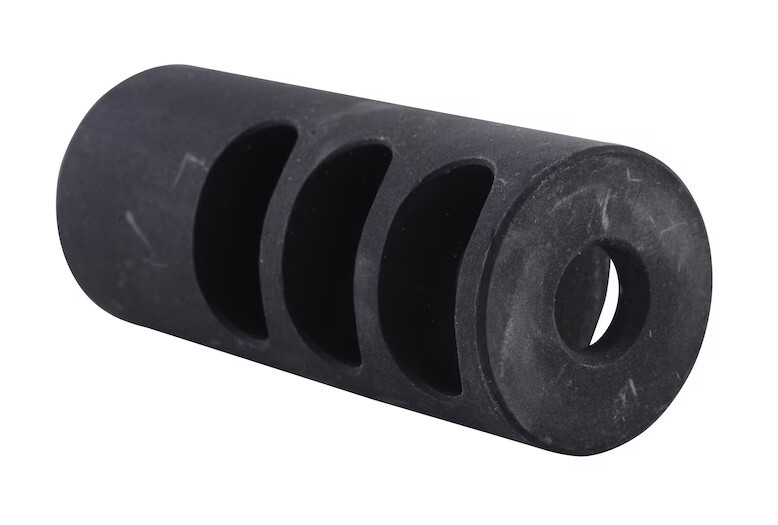
The DPMS Miculek brake stands as a budget-friendly classic in the .308 world. Developed with legendary shooter Jerry Miculek, this straightforward design focuses on raw performance without fancy features or aesthetic flourishes.
Six large side ports aggressively redirect gas to the sides and for this reason it creates a substantial opposing force that noticeably tames .308 recoil. The design is simple but effective, explaining its enduring popularity despite newer, more complex options hitting the market.
The downside to this no-nonsense approach is equally straightforward: significant side blast and concussion. Your shooting neighbors won't thank you for using this brake at a busy range. However, for the price, nothing delivers more pure recoil reduction.
Price: $86
Features
- Six large opposing side ports
- 5/8×24 thread pattern for .308/7.62 barrels
- Jam nut (commonly used term for timing nuts on comps/brakes; keep consistent across entries).
- Approximately 2⅜" length and 3.7 oz (with nut)
- Steel construction with utilitarian finish
Pros
- Excellent recoil reduction for the price
- Simple, proven design
- Easy to find and purchase
- Straightforward installation
- Long track record of reliability
Cons
- Very aggressive side blast
- Very loud at the ear (centerfire rifle peaks are 160 dB+); notable side blast to neighbors.
- Less refined reticle control
- Basic appearance and finish
- Not range neighbor-friendly
9. CMMG ZEROED Muzzle Brake .308
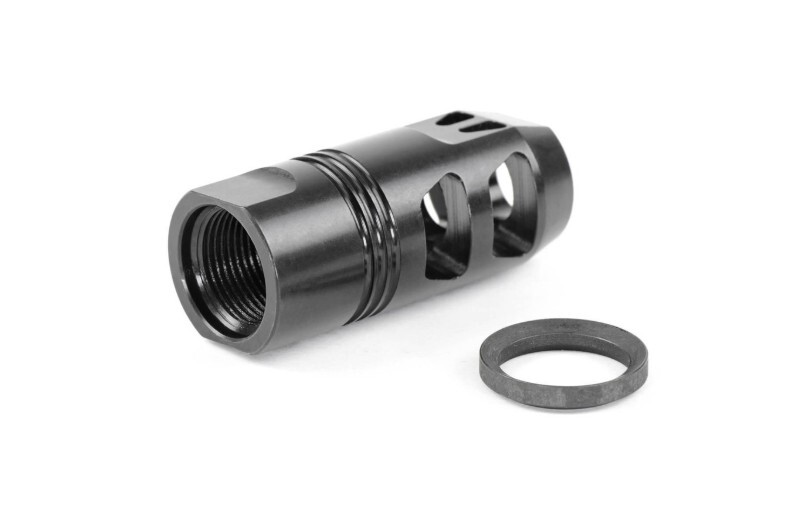
The CMMG ZEROED brake offers a streamlined profile for those who want recoil control without a bulky or aggressive-looking muzzle device. Its slender design adds minimal visual weight to a rifle's front end.
Performance testing shows moderate recoil reduction and some help with muzzle rise. It's not a class leader in raw numbers, but it delivers a noticeable improvement over a standard flash hider without extreme concussion.
The ZEROED brake appears targeted at hunters and practical shooters who want improved control without the bulk or extreme blast of competition-focused brakes. Its clean design and simple installation make it an attractive option for minimalist builds.
Price: $99.95
Features
- Slim, streamlined profile
- 4140 steel construction with nitride finish
- Angled ports for balanced recoil and rise control
- 5/8×24 thread pattern
- Includes crush washer for timing
Pros
- Clean, unobtrusive appearance
- Relatively lightweight
- Easy installation with included hardware
- Durable nitride finish
- Moderate side blast
Cons
- Mid-pack performance for recoil control
- Limited tuning options
- Higher price for its performance class
- Some concussion directed toward shooter
- Less effective for competition applications
10. VG6 Epsilon 7.62 (5/8×24)
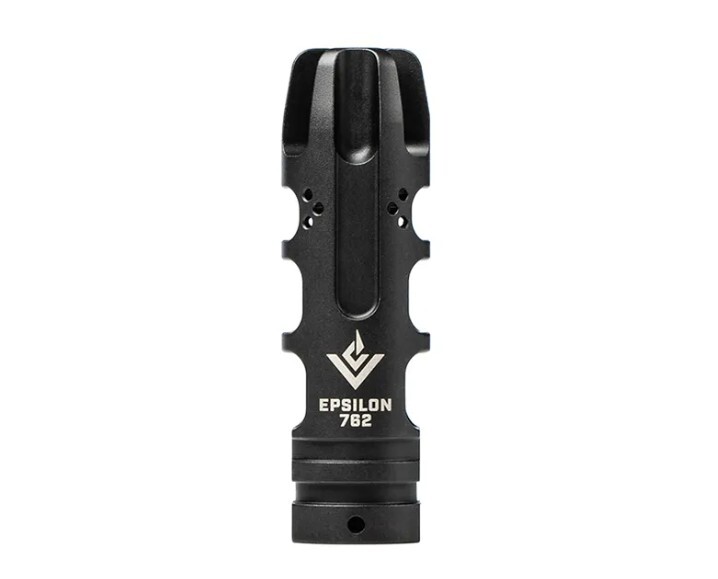
The VG6 Epsilon expands on the Gamma's design by adding flash-hiding prongs to the front of the device. This creates a true hybrid that addresses recoil, muzzle rise, and flash signature simultaneously.
The design incorporates all the recoil-taming side ports of the Gamma but adds effective flash mitigation for low-light shooting. This three-function approach (brake + comp + flash hider) makes it extremely versatile for varied shooting environments.
For those who can't decide between recoil control and flash hiding, the Epsilon offers a compelling one-device solution. The tradeoff comes in slightly increased length and weight over pure brakes or flash hiders, but many users find this acceptable given its multi-role capability.
Price: $99
Features
- Hybrid brake/comp with flash-hiding prongs
- 17-4 stainless steel construction
- 5/8×24 thread pattern for .308/7.62 barrels
- Side ports plus top compensation channels
- Includes timing hardware
Pros
- Multi-role functionality
- Good balance of recoil and flash control
- Attractive and refined design
- High-quality materials and machining
- Widely available
Cons
- More concussion than dedicated flash hiders
- Less flash control than dedicated flash hiders
- Slightly heavier than single-purpose devices
- Premium pricing
- Less tunable than specialized options
Buying Guide
Choosing the right muzzle device means knowing your specific needs:
Home defense or indoor training: Prioritize devices with lower concussion levels like the Fortis RED or Dead Air KeyMount. The extreme blast of competition-focused brakes can be disorienting in enclosed spaces.
Competition shooting: Focus on options with excellent reticle control and return-to-target characteristics. The Lancer Viper with its tunable jets excels here, as does the M4-72 for pure recoil reduction.
Hunting or field use: Consider weight and length carefully. A massive brake might tame recoil beautifully but adds noticeable heft to a rifle you'll carry all day. The Fortis RED and SureFire ProComp offer good performance in compact packages.
suppressor purchase: Start with a brake that doubles as a QD mount (e.g., a KeyMo-compatible brake) so you can add a silencer later without changing devices.
Legal barrel length: Several options include pin holes for permanent attachment, which can add to your barrel's official length. The VG6 Gamma, VG6 Epsilon, and SureFire ProComp all offer this feature.
Setup, Timing & Zero—Quick HowTo

Installing a muzzle brake properly ensures you get the performance you paid for:
- Gather the right tools: You'll need an AR armorer's wrench or appropriate wrench for your brake, proper torque specs, shims or crush washer (as specified by manufacturer), and a good barrel rod or vise blocks.
- Clean and prep: Make sure your barrel threads are clean and lightly oiled. Use the timing hardware specified by the manufacturer. If using a crush washer, install with the flat face to the barrel shoulder and the conical/cupped face toward the muzzle device; otherwise use the provided shim kit.
- Time the brake: Most .308 brakes need to be timed with ports at 3 and 9 o'clock or compensation ports directly at 12. Follow manufacturer guidelines for your specific device. Use shims or crush washers to achieve proper alignment.
- Torque properly: Torque properly: apply the manufacturer’s recommended torque using the device’s wrench flats (do not lever through ports), then re-verify timing.
- Check alignment: Use an alignment gauge to verify the brake is centered on the bore axis. Any contact between the bullet and brake will be catastrophic.
- Test fire and recheck zero: Even properly installed brakes can cause small shifts in point of impact. Test your zero after installation and make any necessary adjustments.
Safety, Hearing & Range Etiquette
Muzzle brakes substantially increase noise and blast. Take these precautions:
Hearing protection is non-negotiable. Double up with foam plugs plus over-ear muffs when shooting braked .308 rifles. Peak impulse levels for .308 rifles regularly exceed 160 dB at the ear, which can cause immediate and permanent hearing damage. Double up with plugs and muffs, especially with brakes.
Be mindful of neighbors at the range. The side blast from powerful brakes can be uncomfortable or even harmful to shooters in adjacent lanes. When possible, take the far end lane or leave space between you and others.
Watch for dust signatures. Brakes with open bottoms can kick up dramatic dust clouds when shooting prone. This can be dangerous in tactical situations and annoying at the range. Choose closed-bottom designs if you shoot prone frequently.
Inspect regularly. Muzzle devices endure extreme conditions. Check for carbon buildup, erosion, or baffle strikes periodically, especially with high round counts.
For a quick rifle matchup: see our Best .308 / 7.62×51 Semi-Auto Rifles Reviewed for platform recommendations that pair well with heavy-duty muzzle brakes.

Federal Gold Medal 308 Win 168gr Boat Tail Hollow Point
$39.73
at Pro Armory
Prices accurate at time of writing
Frequently Asked Questions (FAQs)
1. Do I need a compensator or brake for .308?
A muzzle device isn't strictly necessary, but most shooters find the recoil reduction and improved control well worth the investment, especially for rapid follow-up shots or extended sessions. The .308's substantial recoil benefits significantly from proper management.
2. Will a brake void my barrel warranty?
Generally no, if installed correctly. However, check your specific barrel manufacturer's policies. Improper installation that damages threads or causes baffle strikes could potentially void coverage.
3. What threads do most .308 barrels use?
The standard for .308/7.62 barrels is 5/8×24 TPI (threads per inch). Always verify your specific barrel's threading before ordering a device.
4. How loud is a brake versus a flash hider?
Brakes typically increase sound levels by about 3–5 dB over flash hiders at the ear. Because the decibel scale is logarithmic, +3 dB is roughly double the sound energy—on top of a baseline already well above 160 dB for .308.
5. Can I pin-and-weld a brake to reach legal barrel length?
Yes, if the combined length of your barrel plus permanently attached muzzle device reaches the legal minimum (typically 16" for rifles in the US). Several devices in our list include pre-drilled pin holes specifically for this purpose.
6. Which brakes work with suppressors later?
Devices like the Dead Air KeyMount are designed as both effective brakes and suppressor attachment points. If you plan to add a suppressor later, focus on options from manufacturers with established quick-attach systems.
7. How do tunable ports affect reticle movement?
Tunable ports let you adjust gas flow to counteract your specific rifle's movement pattern. For example, if your rifle consistently pushes up and right, you can open ports that direct gas downward and left to neutralize this motion and this results in a more stable sight picture.
Conclusion
The right muzzle brake transforms a .308 rifle's shooting experience from punishing to pleasant. Each device in our top 10 list offers a unique balance of performance characteristics tailored to different needs and budgets.
For most shooters, the VG6 Gamma 7.62 hits the sweet spot of performance, price, and availability. Those seeking maximum recoil reduction should look to the M4-72 Severe Duty or Ultradyne Apollo Max, accepting the trade-offs in concussion and weight. Budget-conscious buyers can achieve excellent results with the DPMS Miculek brake without breaking the bank.
Proper installation and regular maintenance will ensure your muzzle device delivers the performance benefits you expect. Your shoulder, shooting partners, and targets will all notice the difference a quality brake makes.
About the Author
This article was written by the ProArmory writing team based on current research, including studies from reputable sources like the Journal of Military Science, Firearms News, and the National Shooting Sports Foundation. We also referenced trusted information from official defense publications and respected firearm authorities such as the ATF, NRA, and manufacturer manuals.
Disclaimer: The information provided is for educational purposes only. Always follow manufacturer instructions, local laws, and range rules when installing or using muzzle devices. Proper installation is critical for safety.




 Pro Armory Editorial Team
Pro Armory Editorial Team




